Nestled in the heart of the Pacific, Okinawa is a Japanese Prefecture comprising over 150 islands. It is home to some of the most beautiful pristine beaches and celebrated for its rich Ryukyuan heritage.
Okinawa is a laid back tropical paradise that feels very different from any other parts of Japan. Okinawa is warm for most of the year, with the occasional cooler days during winter. You won’t be surprised to know that it’s often referred to as the Hawaii of Japan, and for good reason.
In late September, my husband and I embarked on a five-day itinerary to explore the main Okinawa island. We discovered an enchanting island with stunning beaches, incredible lush flora and a wealth of attractions. Often overlooked by many who visit Japan, Okinawa feels like a hidden gem with so much to offer, including its unique Ryukyu culture, way of life and local cuisine.
This Okinawa itinerary is crafted from my personal experiences, designed to guide you through the very best of Okinawa. Here’s your ultimate guide to a five-day exploration of Okinawa, capturing its spirit, beauty, and warmth, ensuring you leave with memories that last a lifetime.
Table of Contents
- Know before you go
- Getting to Okinawa
- Getting around Okinawa
- Best time to visit
- Late winter to early spring (late January to early April)
- Autumn (late September to early December)
- Summer
- 5-day Okinawa Itinerary
- Day 1 – Naha
- Morning – Kokusai Dori
- Lunch – Makishi Public Market
- Afternoon – Naminoue Shrine
- Evening – Fukushūen Garden
- Dinner – Kokusai Street Food Village
- Day 2 – Nago & Motobu
- Morning – Nago Pineapple Park
- Lunch – Yamabuki
- After Lunch – Bise-Fukugi Tree Road
- Afternoon – Okinawa Churaumi Aquarium
- Dinner – Columbin
- Day 3 – Nanjo and Nakami
- Morning – Okinawa World
- Lunch – Cape Zanpa Drive-In
- Afternoon – Cape Zanpa
- Afternoon walk on Zanpa Beach
- Dinner – Onna no Eki Nakayukui Market
- Day 4 – Full drive around the island
- Morning – Sesoko Island
- Coffee Break – Bottle Palm Garden
- Cape Hedo
- Lunch – Fushikubu Cafe
- Afternoon – Drive on Highway Route 70 (through Yanbaru National Park)
- Matayoshi Coffee Farm
- Higashi-son Fureai Hirugi Park
- Day 5 – Parasailing and Botanical Gardens
- Morning – Beach day with parasailing
- Afternoon – Southeast Botanical Gardens
- Where to stay in Okinawa
- Final thoughts on my Okinawa itinerary
- Frequently Asked Questions
Know before you go
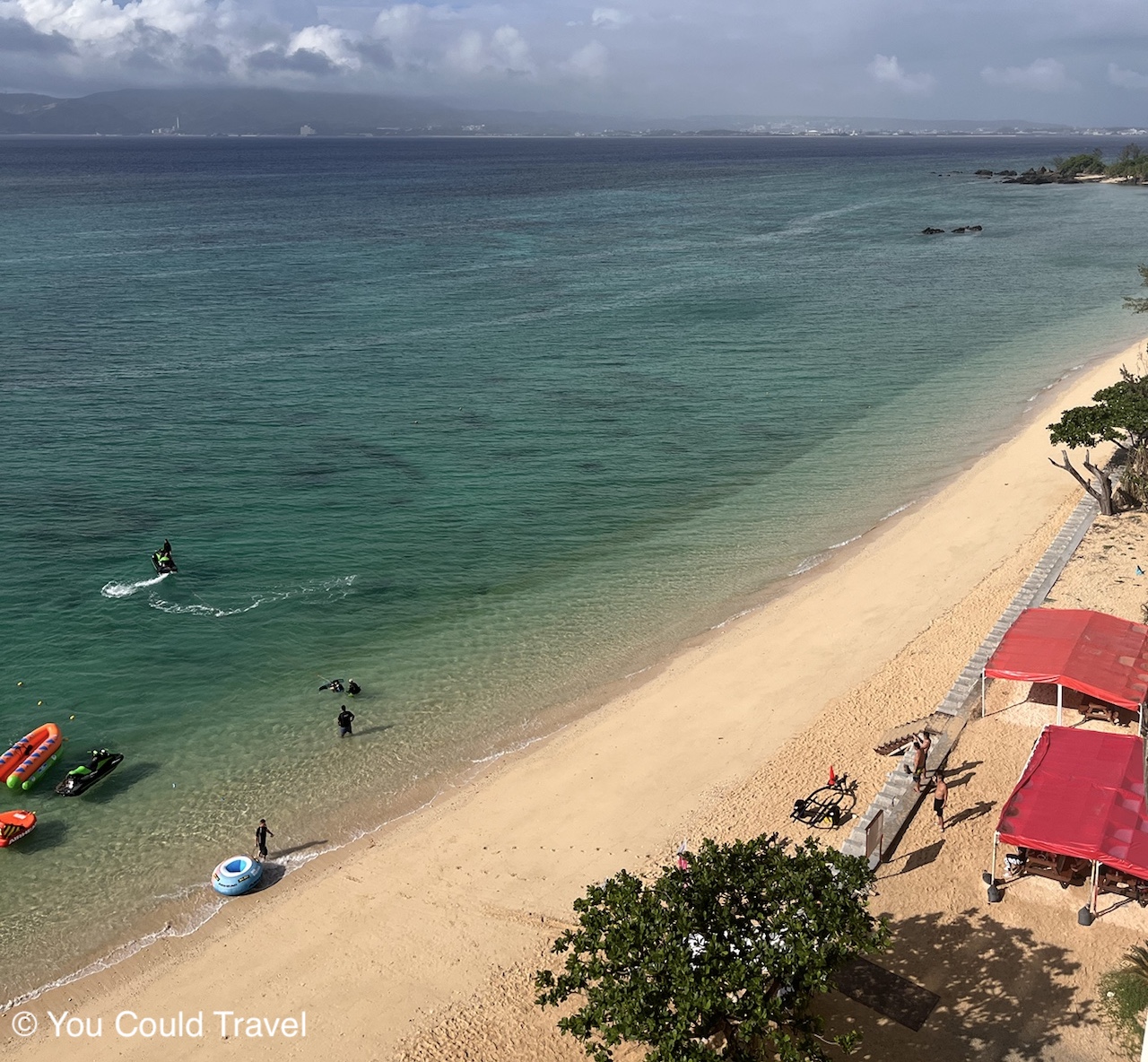
The climate in Okinawa is humid and subtropical. It is hot for most of the year, although during the winter months coats and sweaters might be occasionally needed.
The rainy season is from mid-May until late-June. Typhoon season is from June through mid-September.
Okinawa main island is home to one of the largest US military bases in Japan. There are over 25000 Americans stationed there. Many people speak English, in my experience, even more so than on mainland Japan.
Unlike the rest of Japan, Okinawa has adopted a strong driving culture and public transport is a lot less prominent. There is a monorail available between the airport and Naha city and a tour bus that takes you around some of the tourist points. Buses around the island are infrequent, which normally make your trip harder to plan for.
Food in Okinawa is different than on mainland Japan. While it’s just as delicious and beautifully presented, Okinawans have heartier foods and to my surprise, have a lot more fried items on the menu.
Okinawa is home to the habu snake which is a venomous snake found mainly forests, grasslands, and in the vicinity of rocky areas. They are nocturnal and tend to be more active during the night. If you see this signs 蛇 or はぶ, then that is a known habu habitat so you should stay clear and exercise caution.
The same customs and manners apply to Okinawa as they apply to the rest of Japan. Be polite, respectful and enjoy your time in Okinawa!
Getting to Okinawa

Naha Airport on the main Okinawa island is the main point of entry for visitors to Okinawa. The airport is primarily served by domestic flights from other cities on mainland Japan, including several daily flights to and from Tokyo Haneda/Narita.
There are also some direct international flights from Seoul, Beijing, Shanghai, Taipei, Hong Kong, Singapore and Kuala Lumpur. Every other international flight will transit through Haneda/Narita.
Very Important: When you have a layover at the airport, it’s important to confirm with the ground staff whether you are required to collect your luggage and then recheck it at the domestic terminal. In our experience arriving at Haneda, we had to go through customs, retrieve our luggage, and then recheck it for our domestic flight. It’s crucial to note that your luggage might not be transferred automatically, so double-checking is advisable.
Getting around Okinawa

To explore Okinawa, I recommend renting a car. Renting a car in Okinawa is easy and affordable. When renting a car, make sure to bring your International Driving License which is a legal requirement. Rent with full comprehensive insurance and add an ETC card.
Expressways are well maintained in Okinawa and the fastest and easiest way to get around. By having an ETC card, you will save money and time every time you enter and exit an Expressway.
Signs on the expressways are in Japanese so you should familiarise yourself with a few road markings and signs prior to driving. It’s common that at the rental facilities, the staff show you a few specific Japanese signs, including the stop sign, which is a down-facing triangle.
Refueling in Okinawa is a straightforward process. It’s essential to remember the type of fuel your car requires and indicate its color at the gas station. In most cases, you’ll remain in your car while the staff takes care of fueling and handles the payment directly at your car window.
Best time to visit
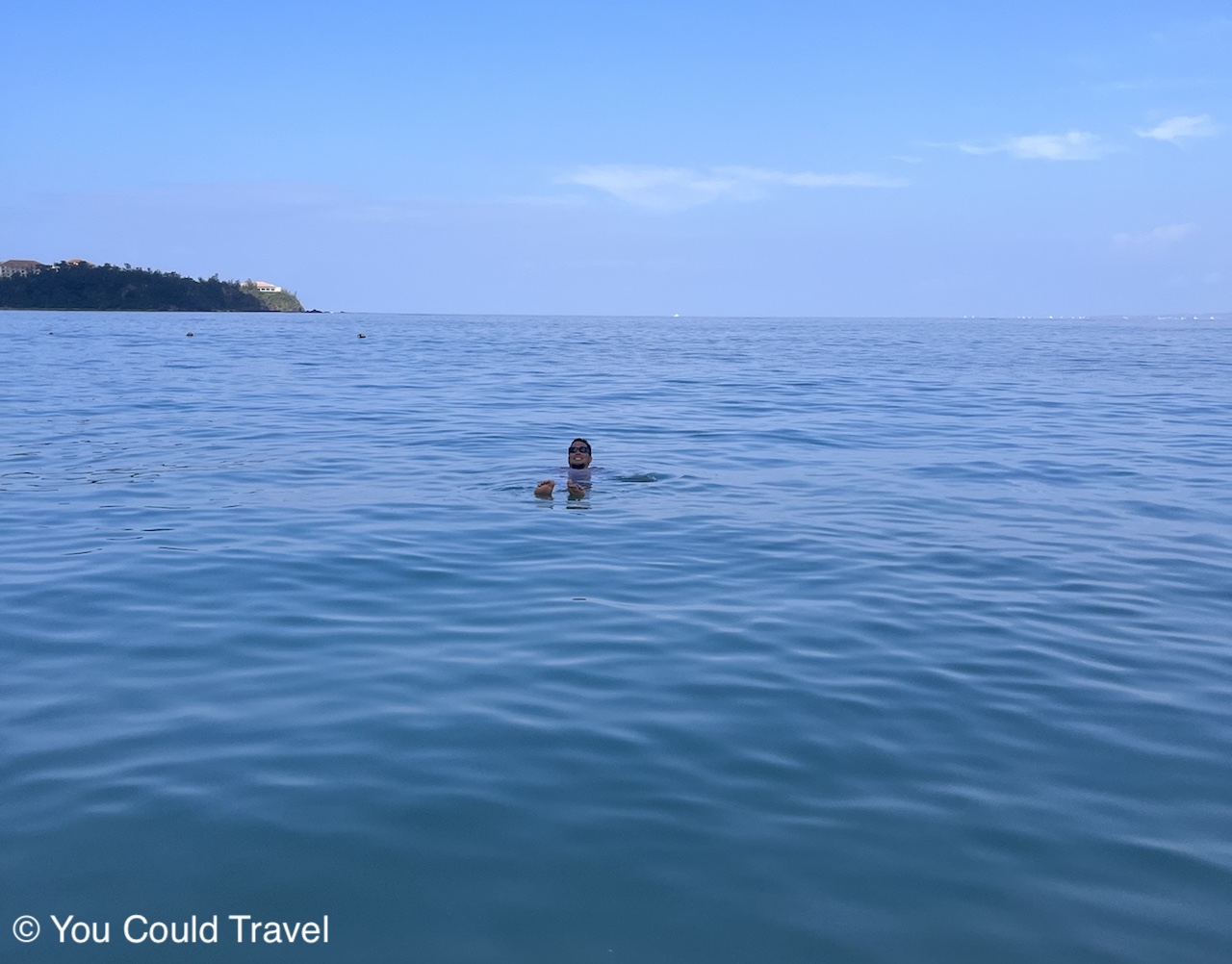
As with most of Japan, Spring, and Autumn are the best times to visit Okinawa.
| Month | Avg Temp (°C) / Avg Temp (°F) | Avg Sea Temp (°C) / Avg Sea Temp (°F) | Best For |
|---|---|---|---|
| January | 17°C / 63°F | 20°C / 68°F | Sightseeing, Culture |
| February | 17°C / 63°F | 19°C / 66°F | Sightseeing, Culture |
| March | 18°C / 64°F | 20°C / 68°F | Sightseeing, Culture |
| April | 21°C / 70°F | 23°C / 73°F | Sightseeing, Outdoors |
| May | 24°C / 75°F | 26°C / 79°F | Beach, Water Sports |
| June | 27°C / 81°F | 28°C / 82°F | Beach, Water Sports |
| July | 29°C / 84°F | 29°C / 84°F | Beach, Water Sports |
| August | 29°C / 84°F | 30°C / 86°F | Beach, Water Sports |
| September | 28°C / 82°F | 29°C / 84°F | Beach, Water Sports |
| October | 25°C / 77°F | 27°C / 81°F | Outdoor Activities |
| November | 22°C / 72°F | 25°C / 77°F | Outdoor Activities |
| December | 19°C / 66°F | 22°C / 72°F | Sightseeing, Culture |
Late winter to early spring (late January to early April)
This period offers cool and comfortable temperatures, making outdoor activities enjoyable. Cherry blossoms typically bloom in late January to early February, adding natural beauty to the landscape.
It’s a good time for sightseeing and outdoor adventures without the heat and humidity of summer.
Beach season starts towards the end of March and the most popular resorts open their beaches for swimming.
Autumn (late September to early December)
Autumn in Okinawa features pleasant temperatures and less humidity. The sea remains warm, making it suitable for beach activities and water sports. We visited in late September and fully enjoyed the beaches and the warm water. It’s a great time for swimming. It was very hot during the day, with daily temperatures of 30C (86F)
Summer
Summer in Okinawa can be extremely hot and humid, and it’s also the busiest time, particularly during school holidays. If you’re not accustomed to high temperatures, humidity, and the potential for typhoons, I would recommend considering a different time to visit.
During these months, it can be uncomfortably hot and rainy, which may detract from the enjoyment of outdoor activities. However, on a positive note, if you love water activities like diving and snorkelling, this is an excellent time to visit, as the sea remains very warm.
5-day Okinawa Itinerary
This is my practical and efficient 5-day itinerary based on my own experiences travelling in Okinawa. I will cover key sites, great places to eat, and beautiful natural wonders, ensuring you make the most of your five days in Okinawa.
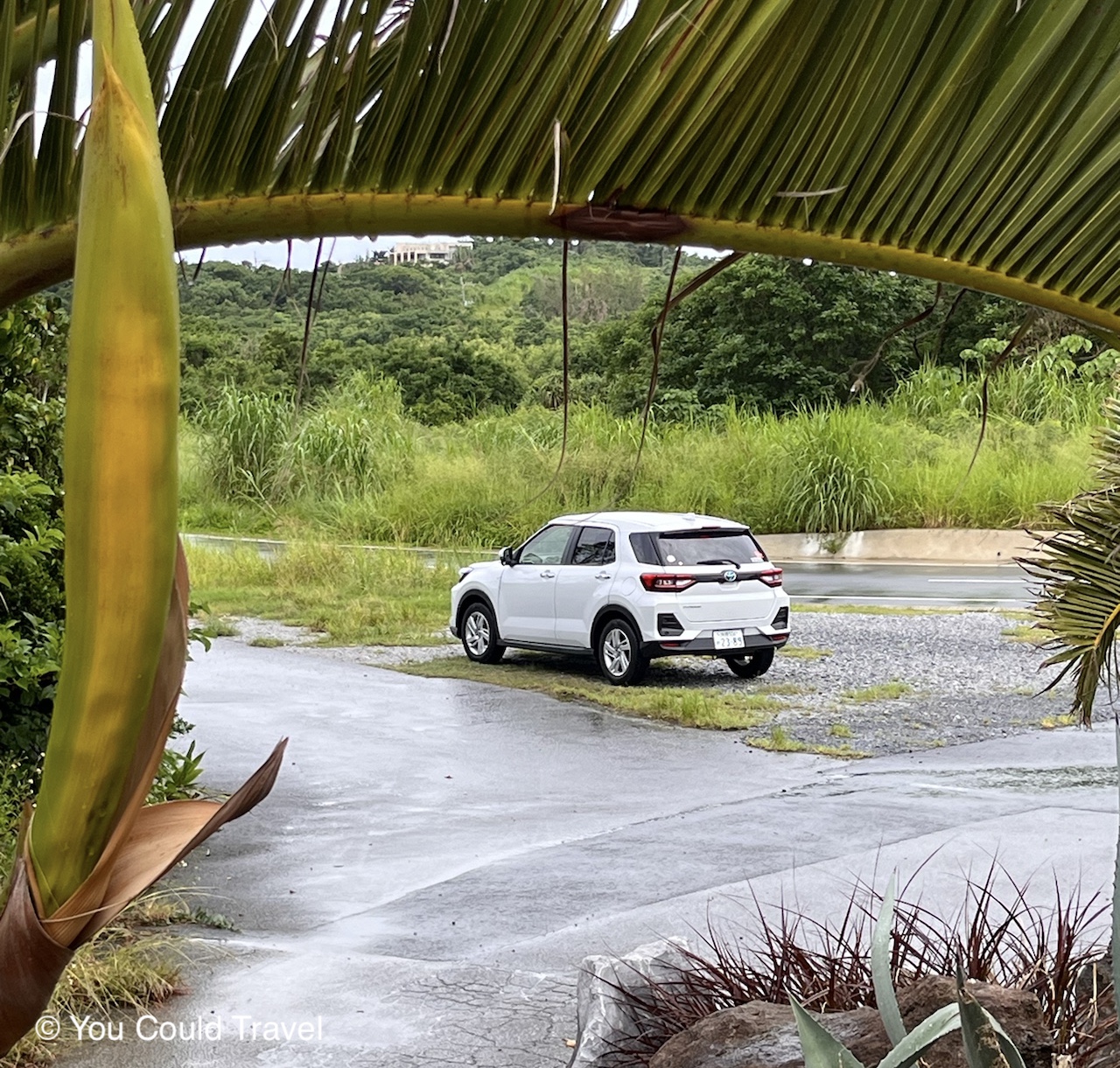
Day 1 – Naha
Start your day bright and early with breakfast at your hotel. There aren’t many breakfast places in Okinawa, so make sure to get a room with breakfast included. It will save your a lot of time and money.
Morning – Kokusai Dori
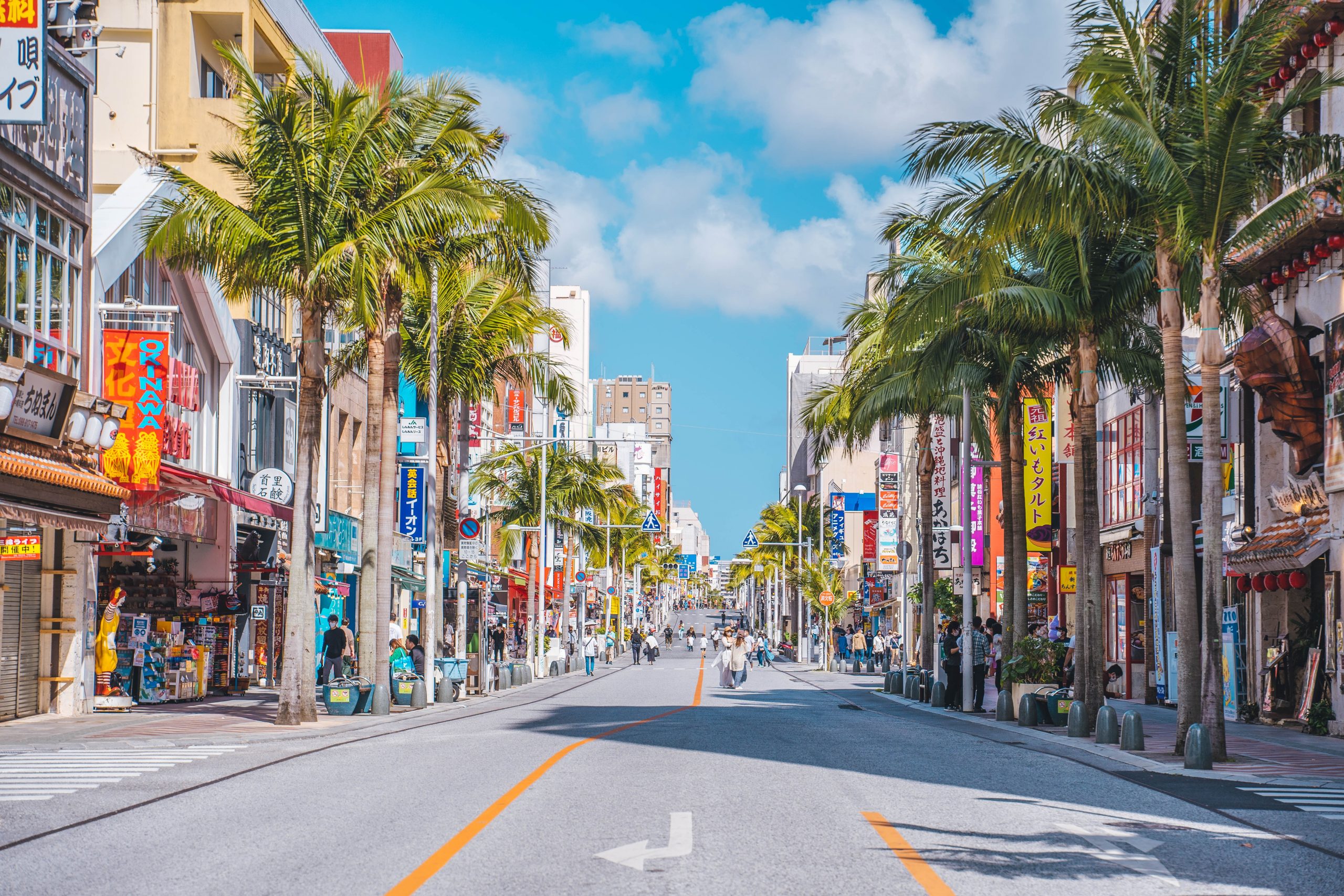
Naha is the capital city of Okinawa. Since you will be flying into Naha, this is one of the best places to start the itinerary. There is plenty to do and explore in Naha, but you will want to start with the Naha Kokusai Dori Shopping Street. This bustling street is filled with shops and restaurants which makes it the best introduction to Okinawa. It’s the perfect place to try local foods like Okinawa soba and Goya Champuru.
Tip: Explore the side streets and markets off Kokusai Dori for unique finds and excellent Japanese souvenirs.
Just a 10 minute walk away, you will find the Tsuboya Yachimun Street, a perfect place for finding local cafés and pottery shops.
Lunch – Makishi Public Market
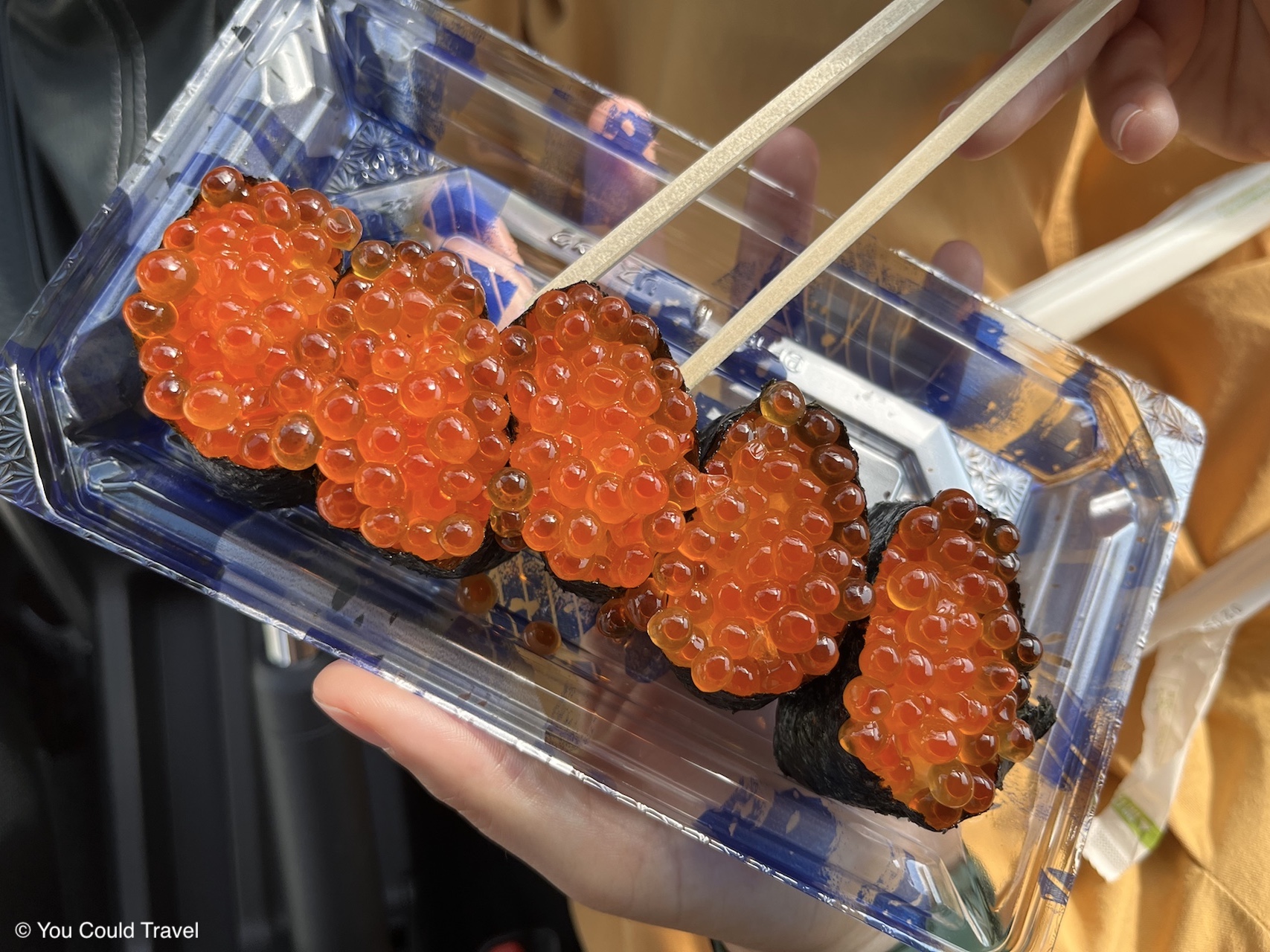
Entry Fee: Free
Address: 2 Chome-10-1 Matsuo, Naha, Okinawa 900-0014, Japan
Opening Hours: 8 am–9 pm
Makishi is a traditional market where you can find fresh seafood, local produce, and Okinawan specialities. Upstairs, there are restaurants where you can have your purchases cooked to order.
Make sure to double-check with the restaurant how much they charge per person to cook your fresh food before seating down.
Afternoon – Naminoue Shrine

Entry Fee: Free
Address: 1 Chome-25-11 Wakasa, Naha, Okinawa 900-0031, Japan
Opening Hours: 9 am–5 pm
Naminoue Shrine is a beautiful Shinto shrine set atop a cliff overlooking the beach. Naminoue Shrine dates back to the Ryukyu Kingdom era. The name Naminoue means above the waves which is a very fitting name given its location.
Originally, Naminoue Shrine was dedicated to Nirai Kanai, a mythical place from where blessings were believed to come. The Ryukyuans prayed here for safety at sea, bountiful harvests, and prosperity.
After suffering significant damage during The Battle of Okinawa in WWII, the main and worship halls were rebuilt in the 1990s to reflect the traditional Ryukyuan architectural style with a striking red-tiled roof and dragon pillars.
From Naminoue shrine walk for a couple of minutes to access the popular Naminoue beach which is accessible for a quick dip and to get the sea breeze.
Evening – Fukushūen Garden
Entry Fee: 80 yen (daytime) or 120 yen (nighttime)
Buy discount tickets in advance from the official site
Address: 2-29-19 Kume, Naha City, Okinawa Prefecture
Opening Hours: 9 am–9 pm
Fukushu-en Garden in Naha is a Chinese-style garden that opened in 1992. It was built to celebrate the relationship between Okinawa and Fuzhou City in China. The garden has a koi pond and stone bridges, making it a good spot for taking photos.
Visiting the garden in the evening is a great idea. The garden is lit up with lights after dark, and the cooler temperatures at night make it comfortable to walk around. The lights add a nice touch to the garden’s paths and landscapes, making it a pleasant place to visit in the evening.
Dinner – Kokusai Street Food Village
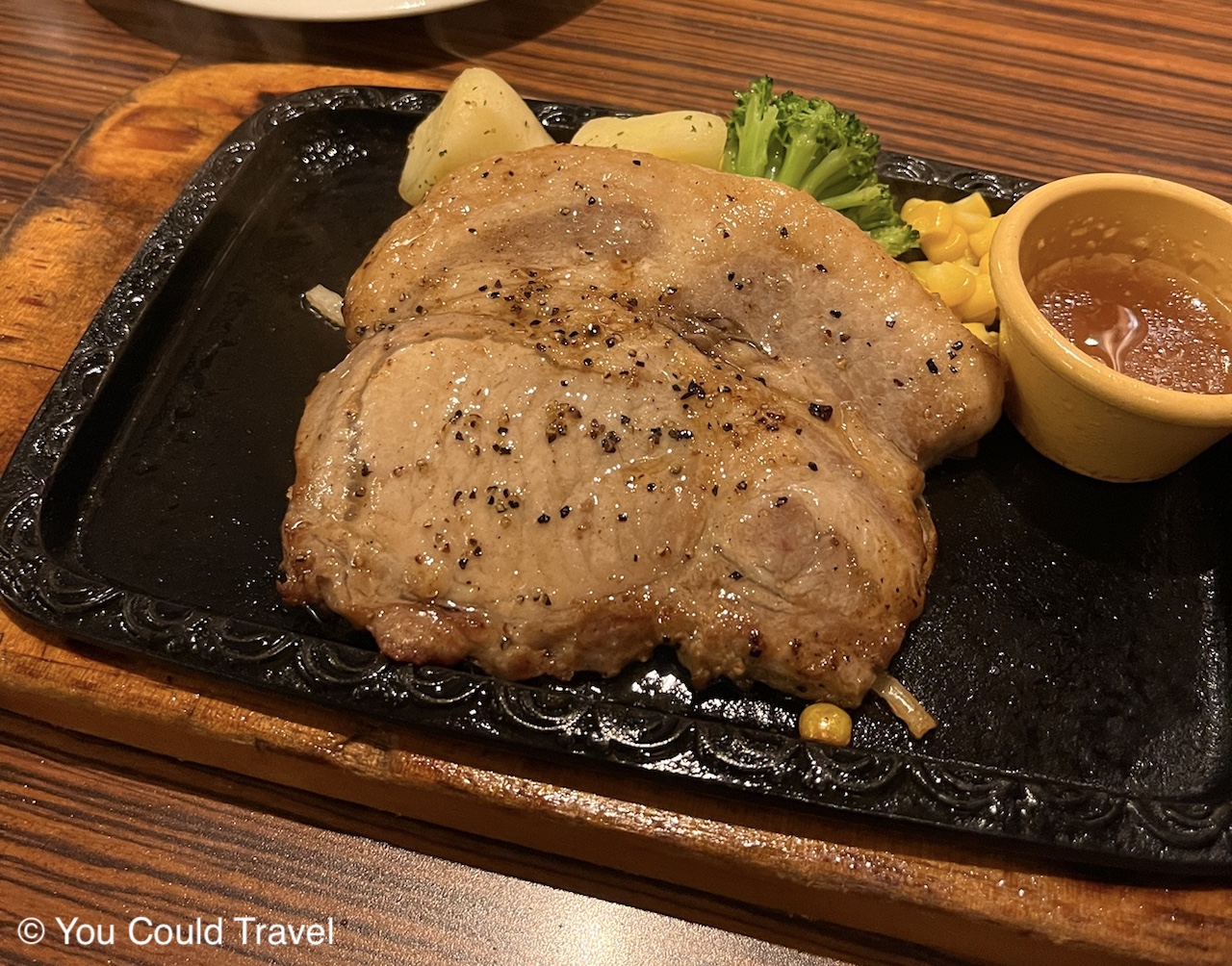
Entry Fee: Free
Address: 3 Chome-11-17 Makishi, Naha, Okinawa 900-0013, Japan
Opening Hours: 12 pm–12 am
Nothing says dinner in Okinawa more than going from stall to stall to pick up all sorts of street food. There are 21 stalls, each specialising in specific dishes. There gyoza, sashimi, okonomiyaki, sushi, steak and udon. If you fancy it, you’ll find it here. And all restaurants have their own drinks too, so you can try a variety of specialisties. This is the time to try Orion beer, which is Okinawan. For something a little more unusual, order Awamori which is a traditional alcoholic beverage unique to Okinawa made from long-grain Thai rice.
Day 2 – Nago & Motobu
Take your car rental and drive from your hotel to Nago Pineapple Park. Use Google Maps for directions to make it easier to navigate around Okinawa.
Morning – Nago Pineapple Park

Entry Fee: 1100 yen (Buy discounted ticket online)
Address: 1195 Biimata, Nago, Okinawa 905-0005, Japan
Opening Hours: 10am-6pm
Full article on Nago Pineapple Park
Nago Pineapple Park is a really fun tourist attraction dedicated to (you guess it) pineapples. After you park your car in the free carpark, you will be taken to the entrance by a pineapple themed tractor. You’ll then take a pineapple photo and continue your tour in the automatic pineapple shaped carts.
You’ll learn about pineapples and pass pineapple plants. You’ll have the chance to walk around, see tones of gorgeous vegetation and snap lots of pineapple themed photos. There are plenty of shops and restaurants which sell pineapple wine and all sorts of pineapple products, including pineapple pizza (controversial, hehe).
I’m not going to lie, this is a lot of fun for families with kids and I know some tourists think of this park as a little tacky. It sort of is, but that’s literally the joy of it. I visited with my husband, no kids, and still had the time of our lives. I really do recommend it. You can’t visit Okinawa without a trip here.
Lunch – Yamabuki

Address: 1 Chome-7-19 Ohigashi, Nago, Okinawa 905-0016, Japan
Opening Hours: 11:30 am–2:30 pm; 6–9 pm
Yamabuki is a kaiseki restaurant ran by a local lady called Eriko Shinzato. I don’t exaggerate when I say that this meal was the highlight of our Okinawa trip. We both ordered the Tempura Makunouchi and what a joy it was. Crispy tempura with rice, sashimi, boiled food, vinegared food, salad and udon. The creme de la creme was the special purple sweet potato drink which is unique to Yamabuki.
Tea or coffee as well as a small fresh fruit for dessert is also included in the price. A lunch set costs ¥2000 – ¥2700 per person.
Yamabuki is 10 minute drive from Nago Pineapple Park. There is free parking right in front of the restaurant which comes in handy.
After Lunch – Bise-Fukugi Tree Road
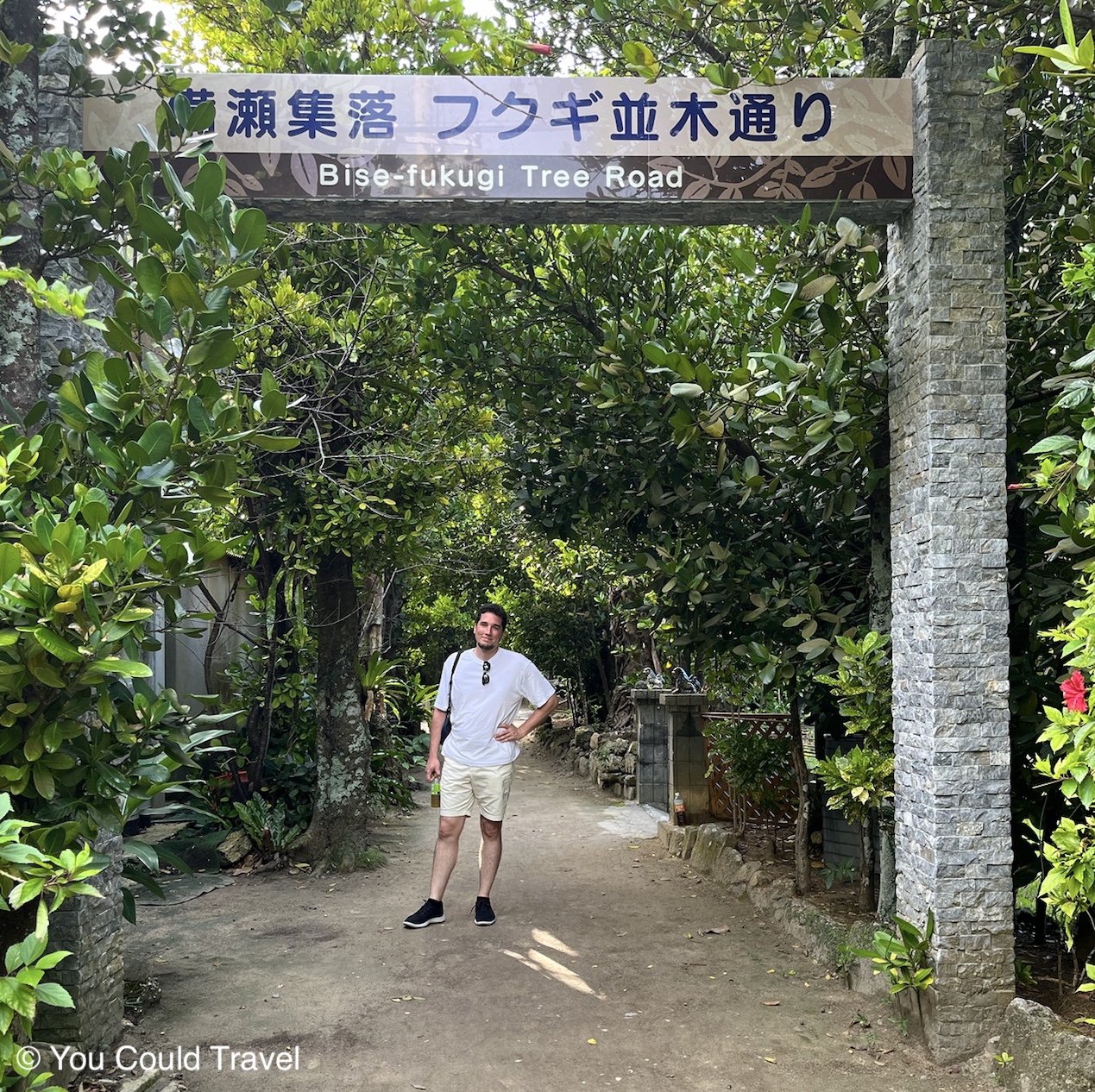
Entry Fee: Free
Address: 389 Bise, Motobu, Kunigami District, Okinawa 905-0207, Japan
Opening Hours: 24/7
Next on the itinerary is the magnificent Bise-Fukugi Tree Road. Bise-Fukugi Tree Road is a picturesque path located in the village of Bise. The slightly sandy, scenic road is lined with Fukugi trees, which are evergreen trees native to the region. The trees were originally planted by locals centuries ago to protect their homes from strong winds and salt damage caused by typhoons.
The path is around 1.5 kilometers long and leads to the beautiful beaches of Bise, such as the very popular Kokuei Okinawakinenkoen Emerald Beach.
According to Okinawan lore, couples who walk hand-in-hand under the Fukugi trees of this road will be blessed with eternal love?
Important Advice: Remember to carry insect repellent, as there are a significant number of mosquitoes in the shaded areas.
Afternoon – Okinawa Churaumi Aquarium

Entry Fee: 2100 yen (Buy your tickets online)
Address: 424 Ishikawa, Motobu, Kunigami District, Okinawa 905-0206, Japan
Opening Hours: 8:30 am–6:30 pm
The Okinawa Churaumi Aquarium is one of the largest and most impressive aquariums in the world. It’s famous for its massive Kuroshio Sea tank, which holds 7,500 cubic meters of water and offers a clear view of whale sharks and manta rays.
Like most aquariums in Japan, it’s divided into several zones, each focusing on different aspects of aquatic life. The Coral Sea tank, for instance, beautifully displays the vibrant coral reef ecosystems.
Dinner – Columbin
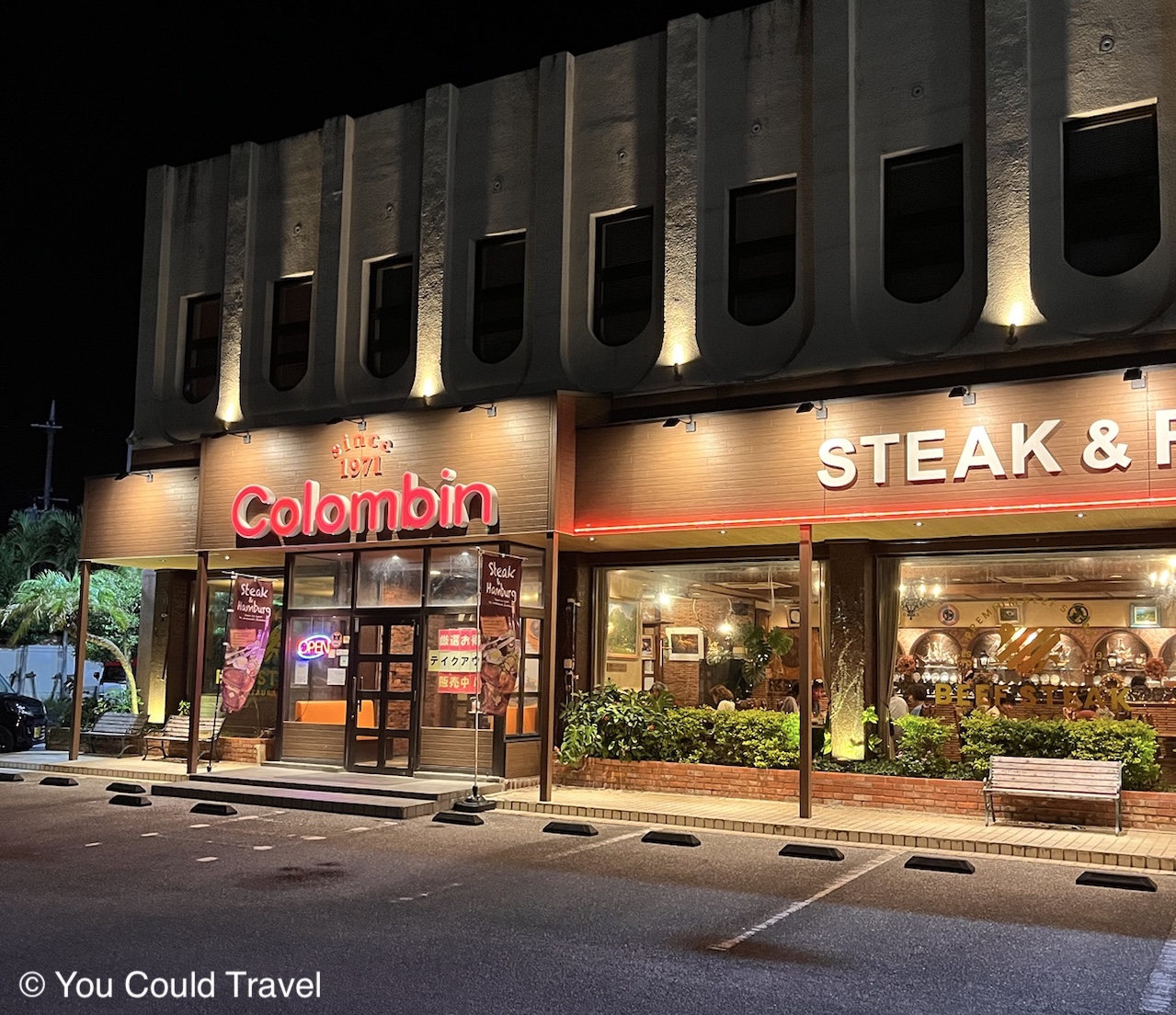
Address: 71-1 Koki, Nago, Okinawa 905-0025, Japan
Opening Hours: 11:20 am–9 pm
There are plenty of restaurant options around the Okinawa Churaumi Aquarium including Kairo which focuses on traditional local foods, and Raddish, a popular Italian that serves pizza and pasta.
On our way back to the hotel we stopped at Columbin, a local restaurant near the very beautiful Weed Beach. Columbin specialises in steak dishes as well as Okinawan sets. Their cocktails stand out as some are made with Shiikwaasa fruits is grown in Okinawa.
Day 3 – Nanjo and Nakami
Today is about mixing culture and history with stunning natural beauty. Start the day learning about Okinawa at Okinawa world, then explore the beautiful path to Cape Zanpa. You’ll end the day at the most popular food market, which happens to also be a car pit stop.
Morning – Okinawa World

Entry Fee: 2000 yen (Buy your tickets online)
Address: Maekawa-1336 Tamagusuku, Nanjo, Okinawa 901-0616, Japan
Opening Hours: 9 am–5:30 pm
Okinawa World is a must-visit on any Okinawa itinerary because it’s a cultural theme park. The main highlight is the Gyokusendo cave, which was surprisingly so much larger than anticipated. We walked for a good 30 minutes in it to explore it all. There are so many beautiful photo moments in the cave. For this alone, it’s worth seeing.
You’ll then walk around the traditional Ryukyu Village which recreates a traditional Okinawan village, complete with old-style houses and workshops. Watch and participate in various traditional crafts such as weaving, pottery, and glass blowing.
There are many cultural shows and even a large shopping area to purchase local specialities and Okinawan souvenirs.
Lunch – Cape Zanpa Drive-In
Address: 1861 Uza, Yomitan, Nakagami District, Okinawa 904-0328, Japan
Opening Hours: 10 am–7 pm
Cape Zanpa Drive-In is a lovely local café which sells food and drinks. Their purple sweet potato fries are especially delicious. There are many chicken and sausage burgers on the menu served with a side of your choice. Oat milk is available for your coffee for a small additional fee.
Afternoon – Cape Zanpa
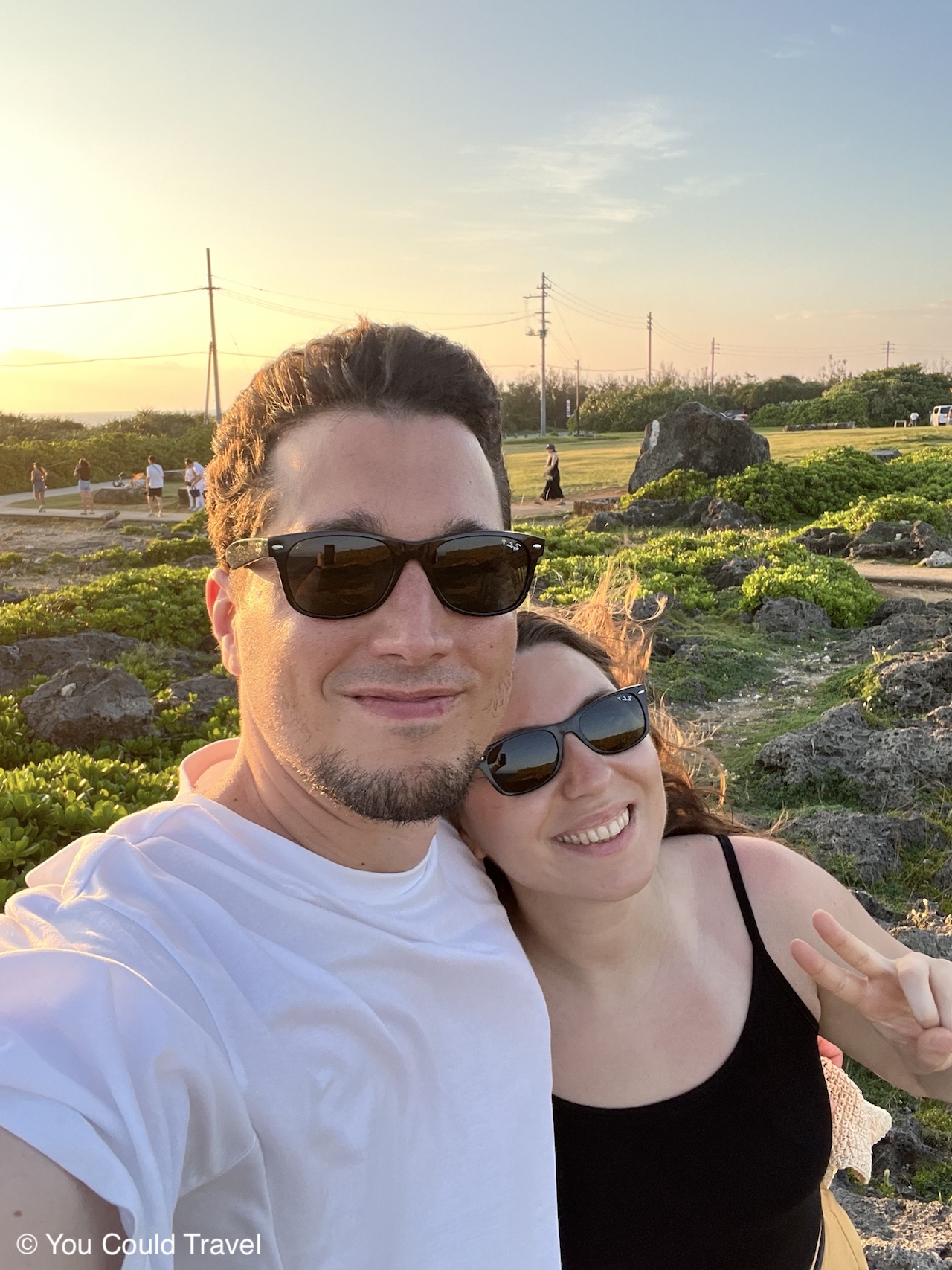

Address: Uza, Yomitan, Nakagami District, Okinawa 904-0328, Japan
Cape Zanpa is a scenic point located on the western coast of Okinawa island. Park your car, then walk towards the main attraction which is the prominent white lighthouse. For a small 300 yen fee, you can climb it and admire panoramic views of the East China Sea. It was too windy when we visited, so we decided to just admire the rugged terrain instead.
The cape has dramatic cliffs, which rise sharply from the turquoise waters below. The views are particularly stunning at sunset, which is when I recommend visiting.
There are well-maintained paths along the cape, but please stick to the beaten path, as there the rocky areas are a natural habu habitat area.
Afternoon walk on Zanpa Beach
Zanpa Beach is a beautiful sandy beach from where you can observe some of the most gorgeous sunsets in Okinawa. The beach is well-suited for various water sports, including swimming, snorkeling, and jet skiing. The clear water provides good visibility for snorkelers looking to explore the underwater world.
With its gentle waves and clean environment, Zanpa Beach is a family-friendly location. It’s easy to rent banana boats and snorkelling gear here.
Dinner – Onna no Eki Nakayukui Market
Address: 1656-9 Nakadomari, Onna, Kunigami District, Okinawa 904-0415, Japan
Opening Hours: 10 am–7 pm
Onna no Eki Nakayukui Market are one of the most popular motorway services in the whole of Japan. Why? Because it has a variety of stalls selling all sorts of food and desserts. People come here specifically to eat, which in turn it increased its popularity with drivers.
There is a bakery, fresh fish dishes and the super popular Kanachan Onna Station which sells Okinawan black sugar steamed cakes.
Day 4 – Full drive around the island
Today is all about discovering the most hidden spots on the island. The joy is in driving around the island and discovering incredible places which are well off the beaten path. From experience, I recommend having enough water and snacks with you for a more enjoyable drive, although don’t worry, I will tell you where to stop along the way.
Morning – Sesoko Island
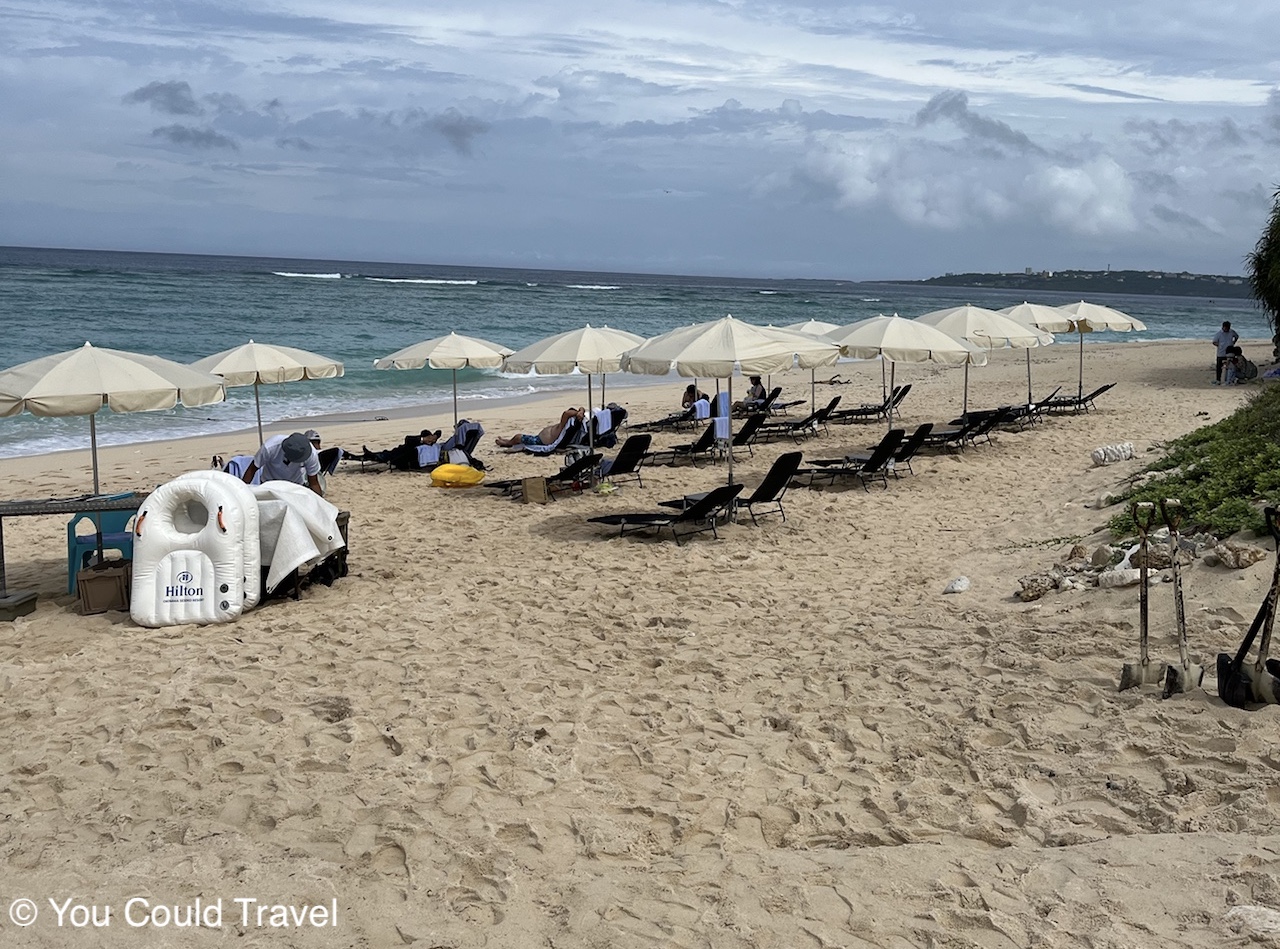
The first stop is the beautiful (and exclusive) Sesoko Island. The Hilton Okinawa is located here with its own beach called Sesoko beach. There is public parking available just a minutes walk from the beach. Parking costs 500-1000 yen depending on the season.
Sesoko beach is a white sandy beach with gorgeous views of the ocean. It’s perfect for a nice walk on the beach or just a quick dip in the water.
Remember that beaches open from end of March until around December so please double check opening times before your visit.
Coffee Break – Bottle Palm Garden

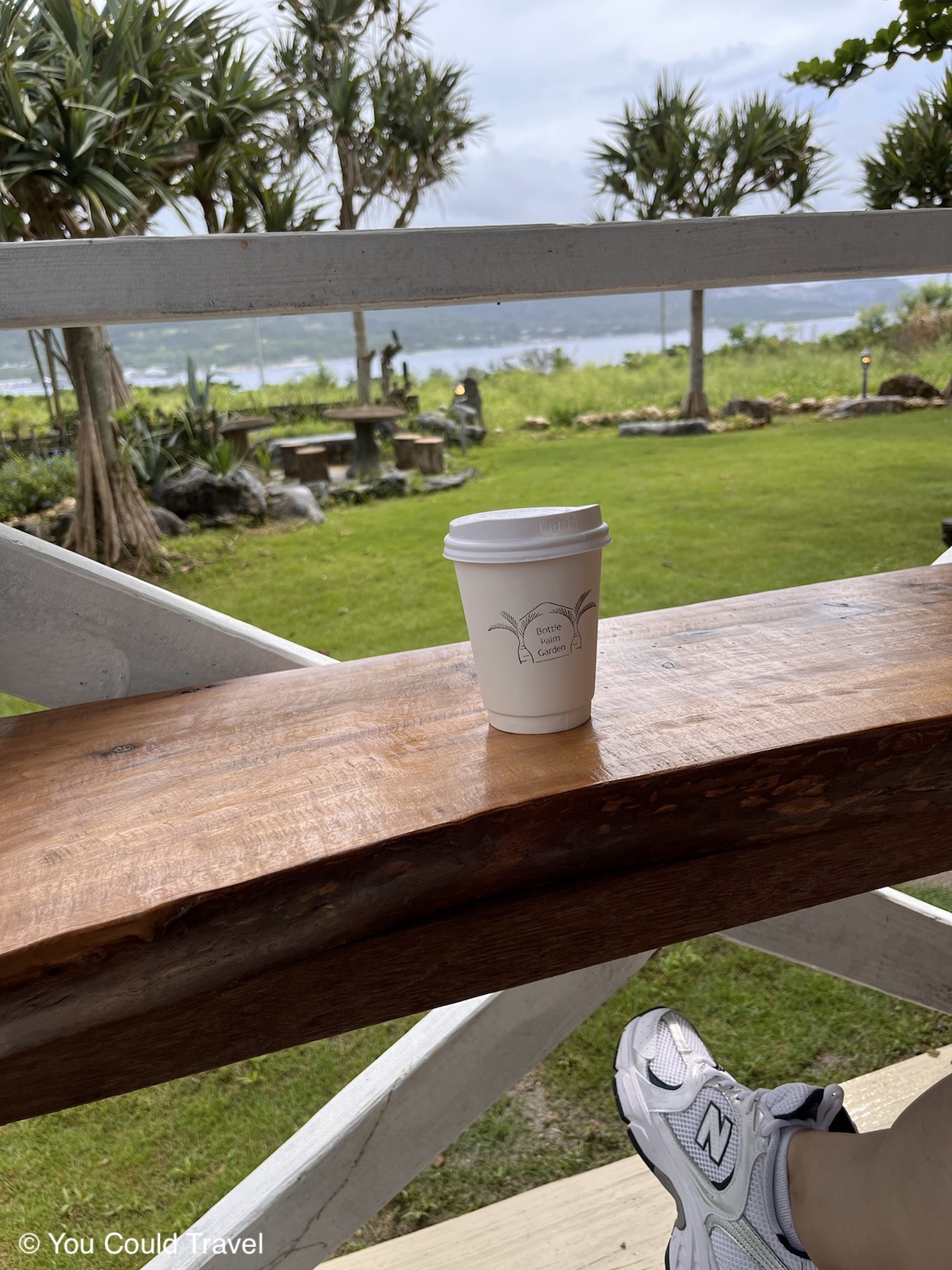

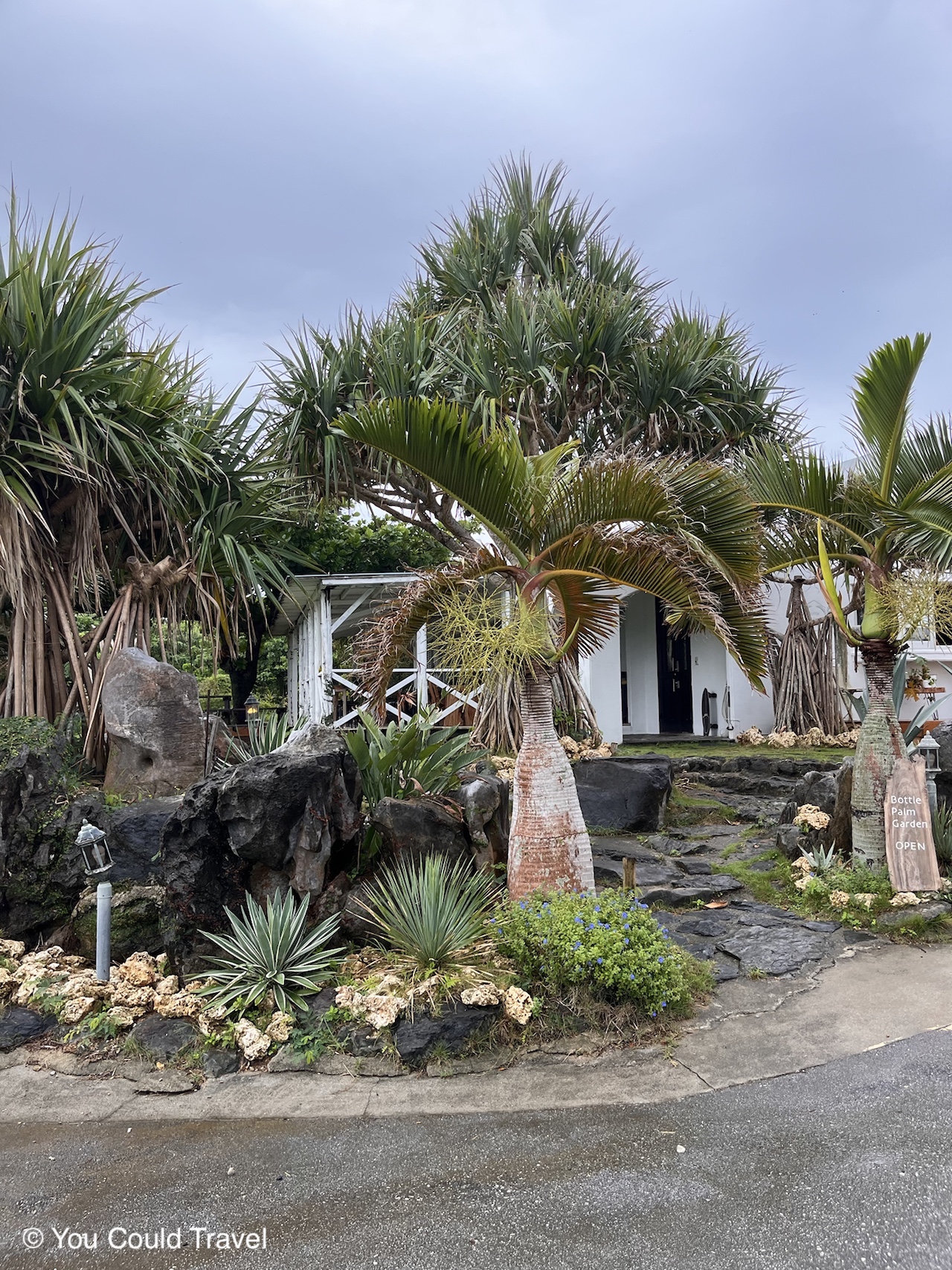
Address: 4054-1 Sesoko, Motobu, Kunigami District, Okinawa 905-0227, Japan
Opening Times: 8 am–5 pm
Hidden gem alert, the Bottle Palm Garden was the most beautiful coffee shop I’ve ever visited in my life. It’s located in what looks like someone’s tropical back garden. There are plenty of seats on the porch with views of the garden. The owner makes an incredible coffee, and the best latte I’ve had in Okinawa.
It’s a bit out of the day, but having a coffee in that garden it was such a joy, I can’t not recommend it.
For the next 90 minutes you will be driving along the scenic Western coast of Okinawa. Think blue ocean on the left and gorgeous tropical lush vegetation on the right.
Cape Hedo
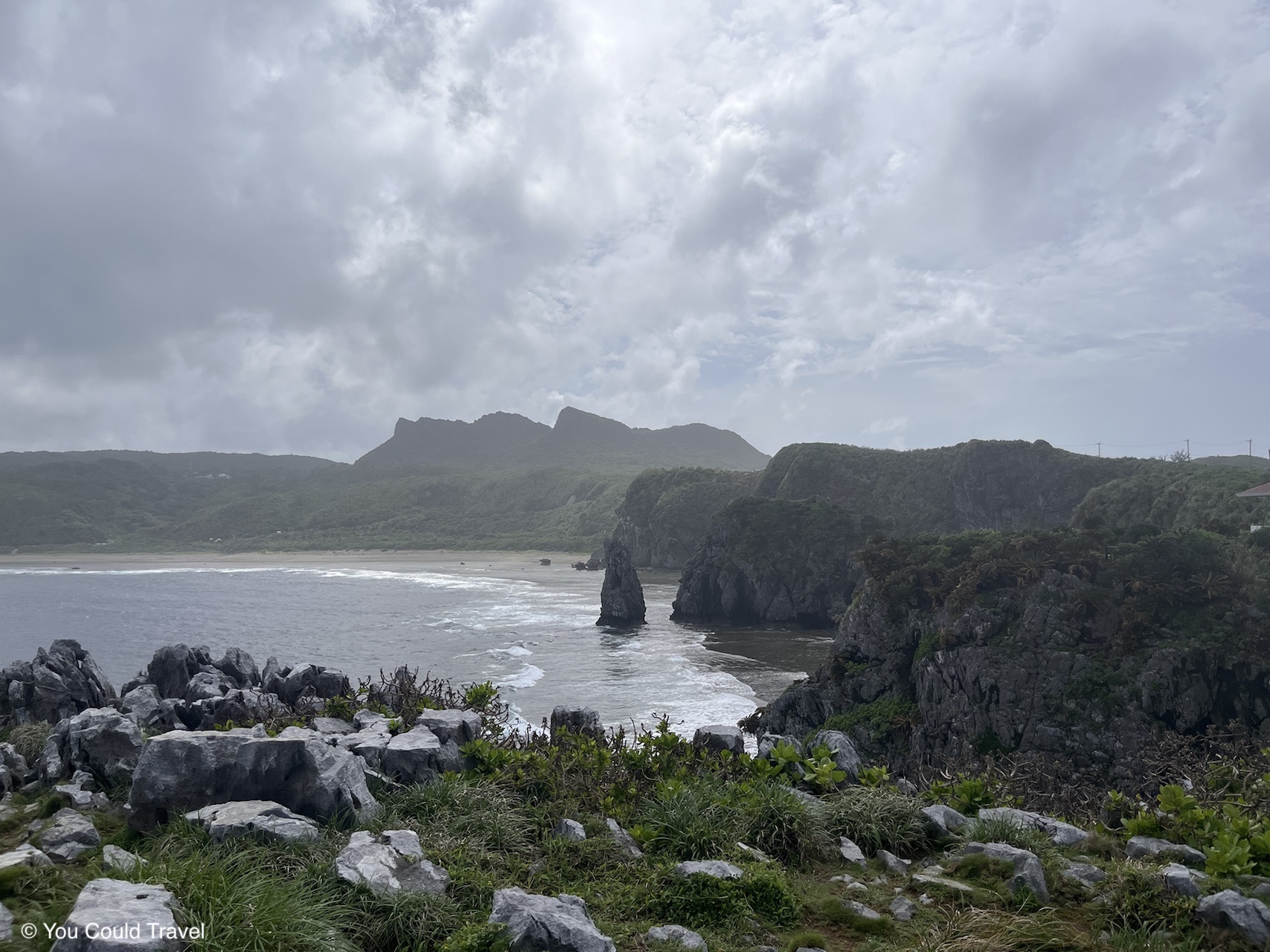
Address: Hedo, Kunigami, Kunigami District, Okinawa 905-1421, Japan
Cape Hedo is the northernmost tip of Okinawa Island. It offers unbelievable views of the Pacific Ocean and it has rugged cliffs and picturesque walking trails. This place is all about the drama with its untamed nature. For hiking enthusiasts, this is the end of the official Japan trail which is a 10,000 kilometre long-distance trail connecting Hokkaido to Okinawa.
There is free parking at Cape Hedo and an information office to learn more about the location.
Lunch – Fushikubu Cafe

Address: Japan, 〒905-1421 Okinawa, Kunigami District, Kunigami, Hedo, 973-5 2F
Opening Hours: 10 am–5 pm (Wednesday Closed)
Fushikubu cafe is located at Cape Hedo. It’s a small café which literally looks like it’s in the middle of nowhere, with a fun and simple menu with affordable prices. We got the Caesar salad chicken wrap (super crunchy and delicious) with a cup of soup (pumpkin soup, which was incredible). That came down to 1200 yen per person. The staff was very lovely and welcoming. There is an English menu available and there is even Cape Hedo merch available as souvenirs as well.
Afternoon – Drive on Highway Route 70 (through Yanbaru National Park)

Take the slower but more scenic Highway Route 70 en route back south. You’ll drive through some parts which feel like a remote jungle. Yanbaru National Park covers a vast expanse of subtropical wilderness, home to a remarkable array of flora and fauna found nowhere else in Japan.
There are plenty of spots along the route, including local monuments and statues, small supermarkets with vending machines for quick refreshments as well as public toilets.
A recommended stop is at Hiro Coffee Farm for a quick snack and a pick me up coffee. It’s just off the main road, located in a really adorable leafy garden area.
Another great pit stop is at Fukuji Dam, which is an observation point. You can see the ocean on one side and the jungle on the other.
For beaches, you will want to check out Nagahama Beach with its cool rock formations.
Matayoshi Coffee Farm

Address: 718-28 Gesashi, Higashi, Kunigami District, Okinawa 905-1205, Japan
Matayoshi Coffee Farm sells coffee with beans grown locally. In their backyard to be precise. They have a whole coffee farm you can visit for a small fee. There is also a small greenhouse you can visit for free.
To enter the estate, you will be taken on a tour and dressed accordingly to ensure you have the right boots for the terrain (and protect against habu). There are toilets onsite as well as a coffee shop where you can order coffee based on the flavour and aroma profile you like.
Higashi-son Fureai Hirugi Park
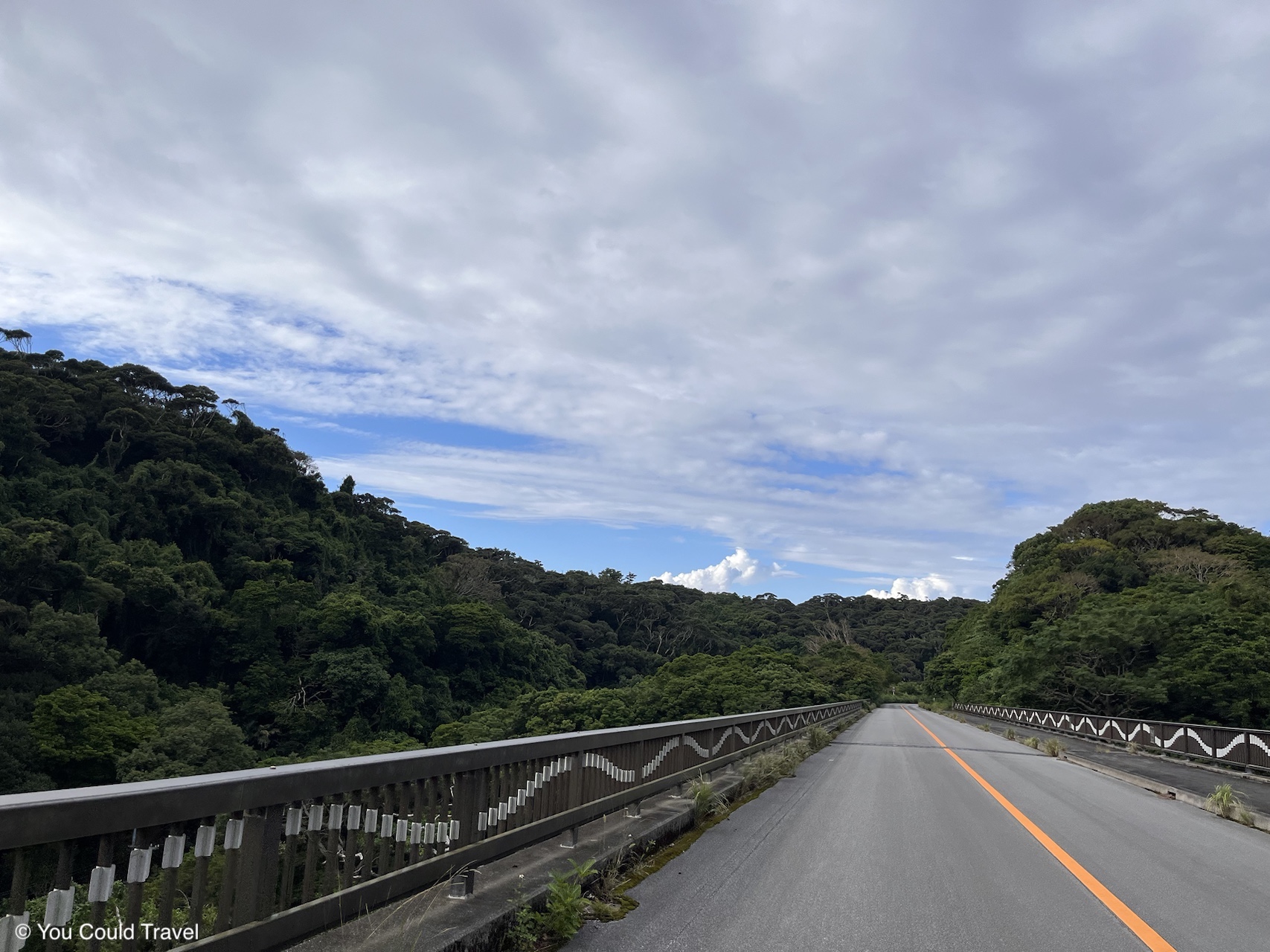
Address: 54-1 Gesashi, 字 Higashi, Kunigami District, Okinawa 905-1205, Japan
Opening Hours: 8:30 am–5:30 pm
Higashi-son is a park where you can walk along the trails and see beautiful mangroves up close. You will see mehirugi, and yaeyama hirugi types of mangroves. For a fun and lively experience, take the canoe tour experience, where you can really close to the roots of the trees.
Please note that the main path was damaged and under construction. It is due to reopen on March 15th 2024.
Day 5 – Parasailing and Botanical Gardens
Today is about combining adrenaline, with stunning sea views, then winding down in the most beautiful botanical garden.
Morning – Beach day with parasailing

Address: Located in Kanehide Kise Beach Palace
Tour Tickets: Official Marine Kise Berry Club
Start your morning with a really cool, adrenaline-fuelled adventure: parasailing. There are plenty of beaches which offer parasailing. We went to the Kise Beach for our parasailing adventure and did the adventure with Marine Club Berry Kise.
You’ll be taken by the team on a boat ride, then geared up with the parasailing straps. You will be given instructions (in Japanese and English). The staff will be taking many pictures and videos of you, so don’t worry, you will have plenty of cool memories of this adventure.
Important information: Take a motion sickness pill before this activity, even if you are not so prone to motion sickness. I am thankful I took one, but a couple of people from our tour were not so lucky. The wind combined with the whole being pulled and rocked sideways can really get you.
Afternoon – Southeast Botanical Gardens
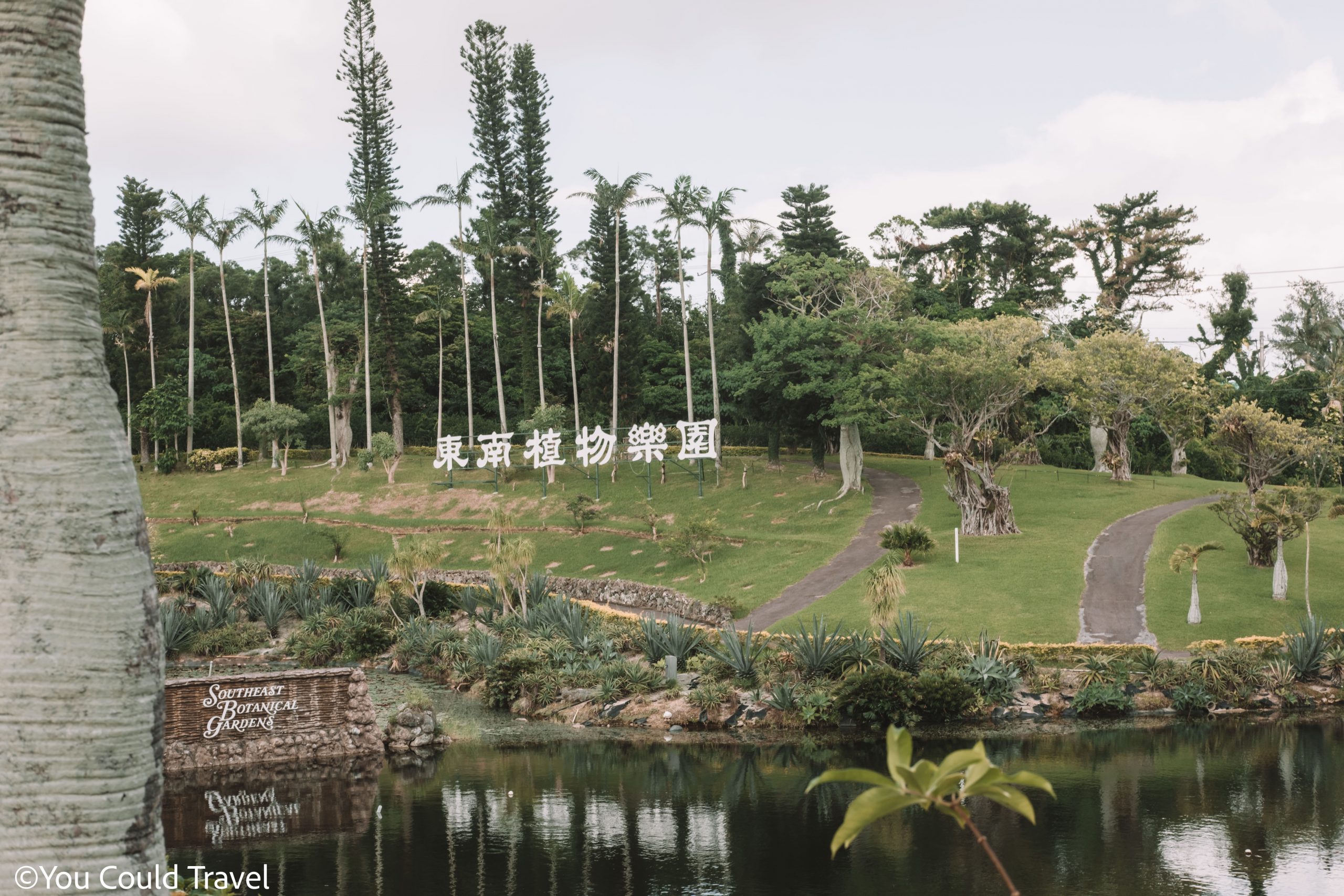
Entry Fee: 1380 yen (Buy discounted ticket online)
Address: 2146 Chibana, Okinawa, 904-2143, Japan
Opening Hours: 9:30 am–10 pm
Full article on Southeast Botanical Gardens
The Okinawa Southeast Botanical Gardens are home to 1,300 species of trees and shrubs. The Okinawa Southeast Botanical Gardens is divided into two gardens: The Water Garden and the Botanical Garden.
The most important highlights here are the lotus pond, the capybara enclosure and the very famous Yusura palm avenue. The botanical gardens are open until 10pm so you can really take your time exploring. There is a restaurant onsite called Peace. Booking a table for your dinner with garden views is recommended.
Where to stay in Okinawa
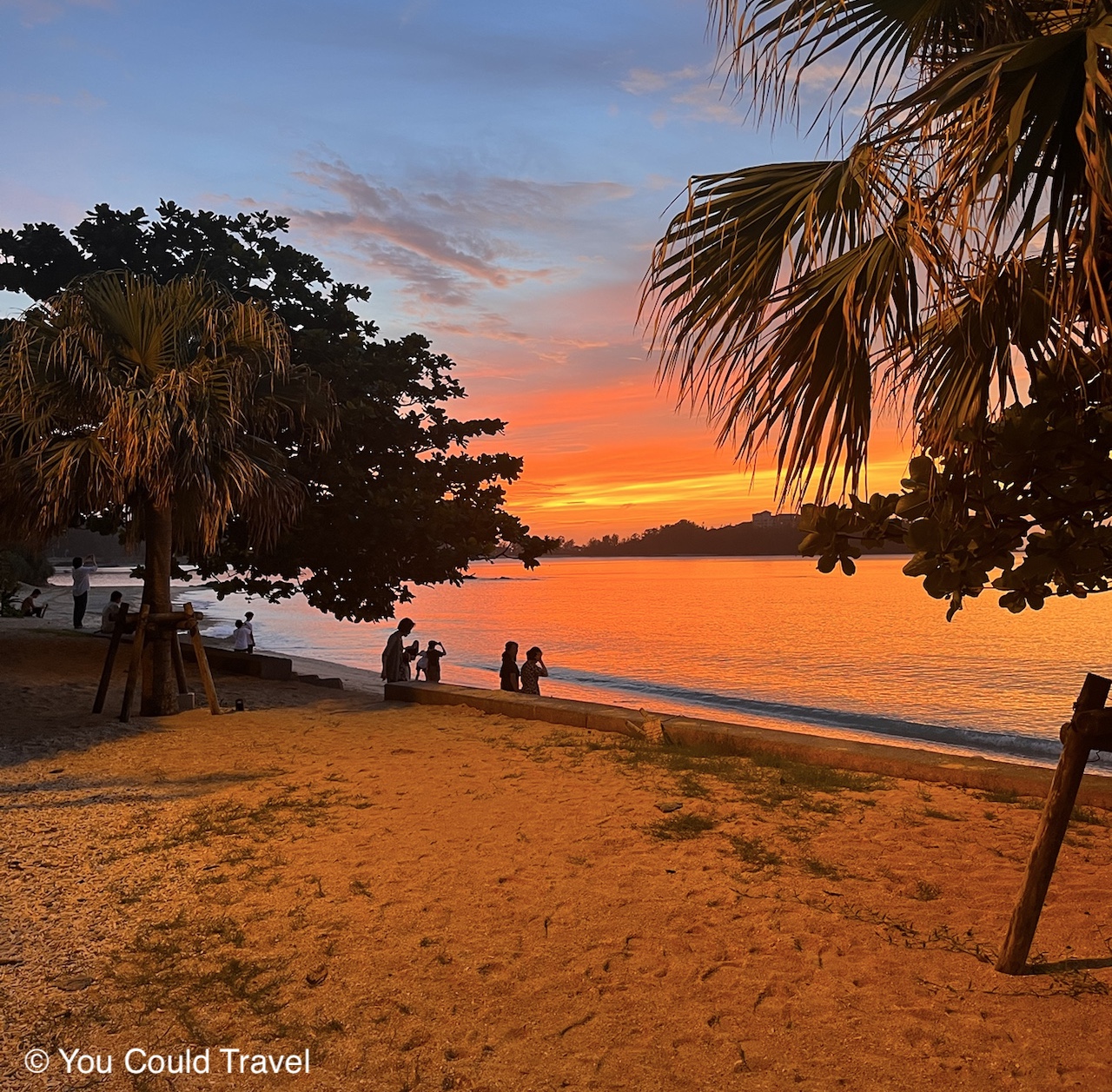
For the duration of this Okinawa trip, we stayed in Onna region, with quick access to beautiful beaches.
Onna is the perfect place to stay if you’re seeking a romantic beach getaway like we did. Onna offers breathtaking ocean views, pristine white-sand beaches, and crystal-clear waters, creating an idyllic and intimate atmosphere for couples. Onna has easy access to the Expressway so you can easily go around the island.
If you are a first-time visitor and want convenience, then you might want to consider Naha city for your base. Please check my full and comprehensive articles on where to stay in Okinawa.
Final thoughts on my Okinawa itinerary
I hope you loved our Okinawa itinerary just as much we did. We loved our time in Okinawa so much, it felt like a second honeymoon with tropical beaches, perfect crystal waters and incredible food. We’re so in love with Okinawa, we’re already planning our next trip there, and we cannot wait to explore more of this tropical paradise.
As previously mentioned the highlights for us were the beaches, especially the Weed Beach, our lunch at Yamabuki which was incredible, the drive around the island to see Cape Hedo and the Southeast Botanical Gardens. I’m glad we got to try parasailing for the first time which was not as scary as I initially thought it will be. And I’m very glad that we went to the Okinawa World which was a lot more spectacular than we’ve been told.
Overall, this was a spectacular trip and one we recommend with lots of love. Enjoy Okinawa!
Frequently Asked Questions
How many days is enough for Okinawa?
Five days is an ideal duration to explore Okinawa, striking a balance between relaxation and adventure. A five-day Okinawa itinerary allows you to experience a diverse range of activities, from historical sites to natural wonders, without feeling overly hurried.
With this timeframe, you can delve into the rich culture and history of Naha, including a visit to Naminoue shrine and the bustling Kokusai Dori, and also experience the stunning natural beauty of the island. You have enough time to venture to the northern parts, like the Okinawa Churaumi Aquarium and the serene beaches of the Motobu Peninsula, as well as enjoying some leisure time at a beach or exploring local markets.
Do I need a car in Okinawa
Yes, renting a car in Okinawa is highly recommended if you’re looking to thoroughly explore the main island. With a car, you have the flexibility to travel between various attractions at your own pace and fully maximize your visit. It’s particularly beneficial for reaching less accessible areas, where public transportation may be limited. The comfort of an air-conditioned car is a plus, especially during warmer months. The roads in Okinawa are well-maintained, and rental cars are generally in excellent condition.
However, if your plan is to mainly relax on the beach or stay predominantly in Naha, a car might not be necessary. For a beach-focused holiday or if you’re staying mostly in the city, using taxis or buses to visit one or two major attractions can be sufficient and more cost-effective.
What is the best month to visit Okinawa?
The best months to visit Okinawa are typically April and October. These months fall within the spring and autumn seasons, offering pleasant weather conditions ideal for exploring the island.
In April, you can enjoy comfortable temperatures, perfect for outdoor activities and beach visits. October, on the other hand, offers the charm of early autumn with slightly milder weather and fewer tourists, making it a great time for a more relaxed experience.
Both months avoid the peak summer heat and the rainy season, ensuring a more comfortable and enjoyable visit to Okinawa.

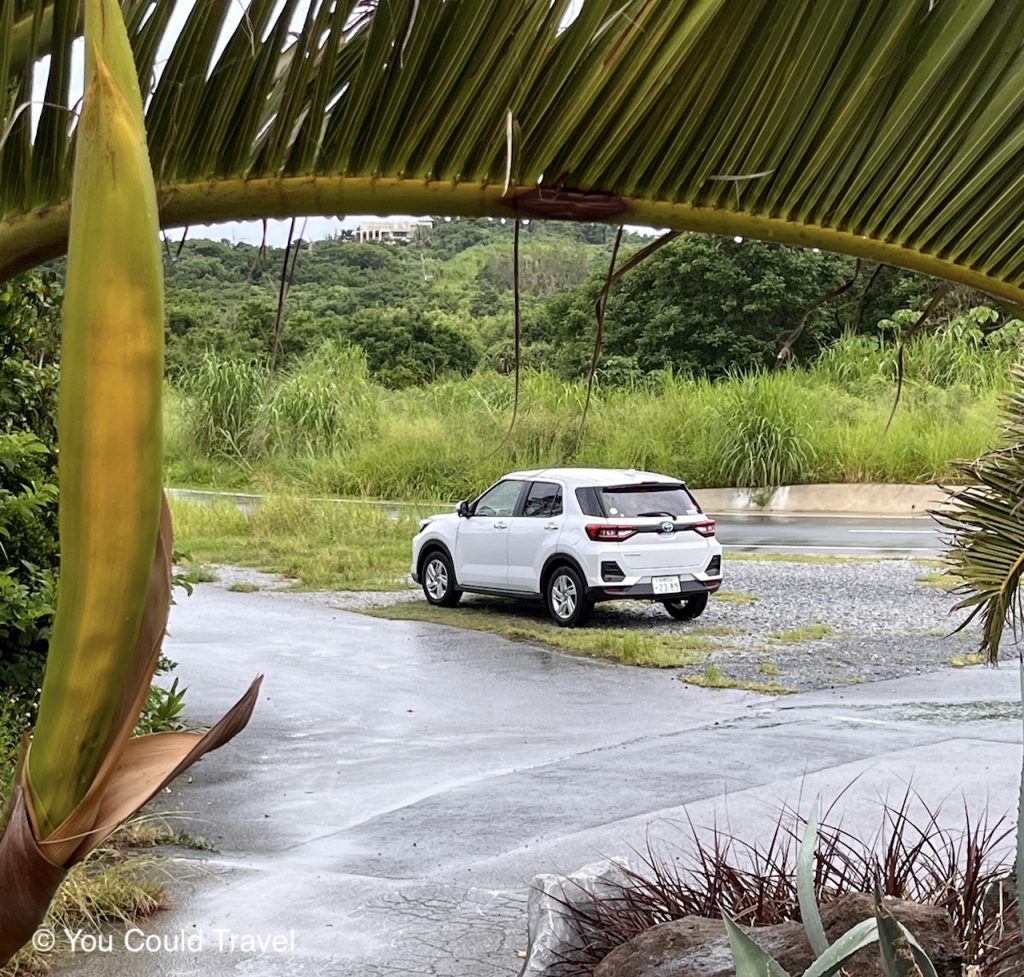
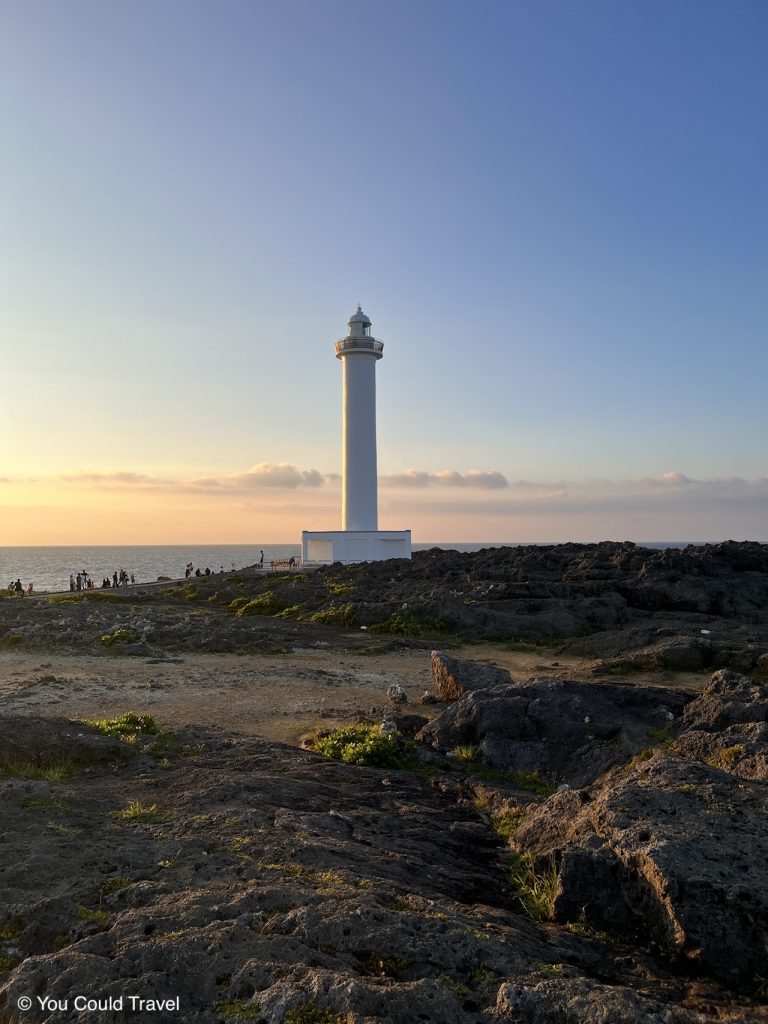

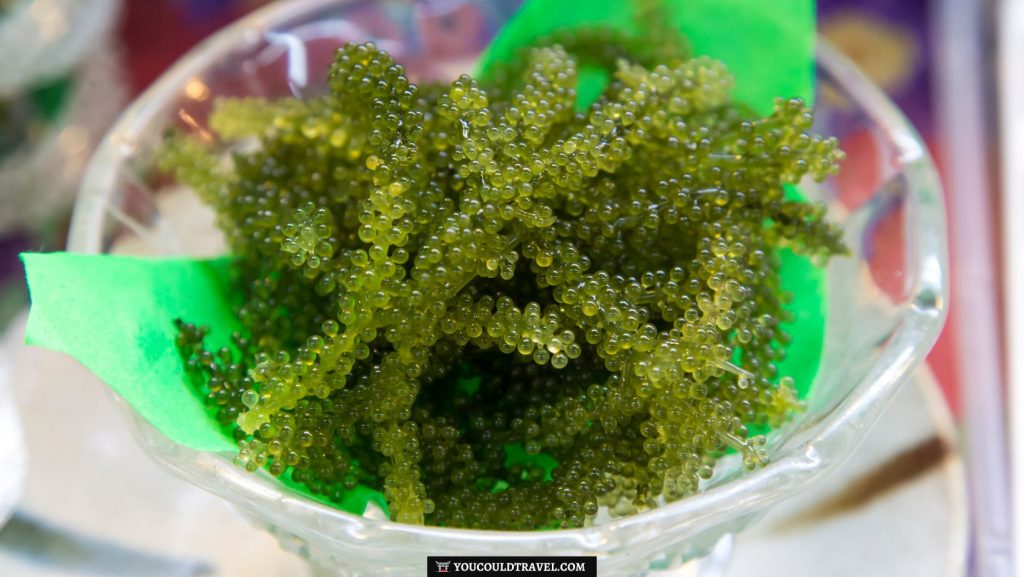
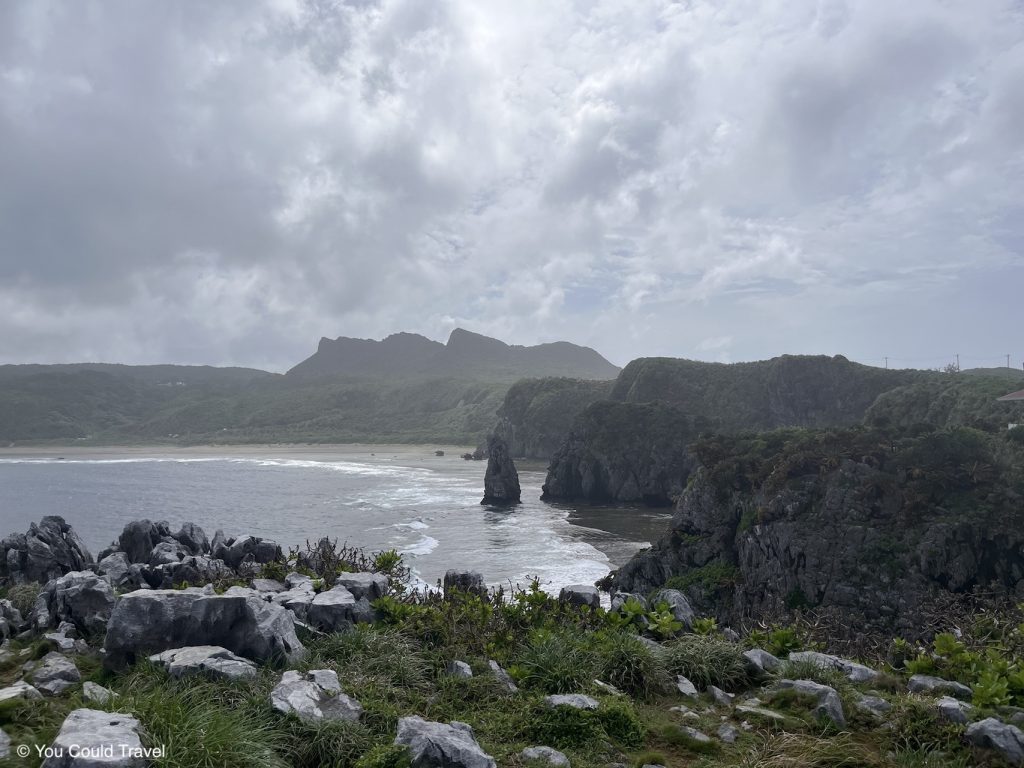
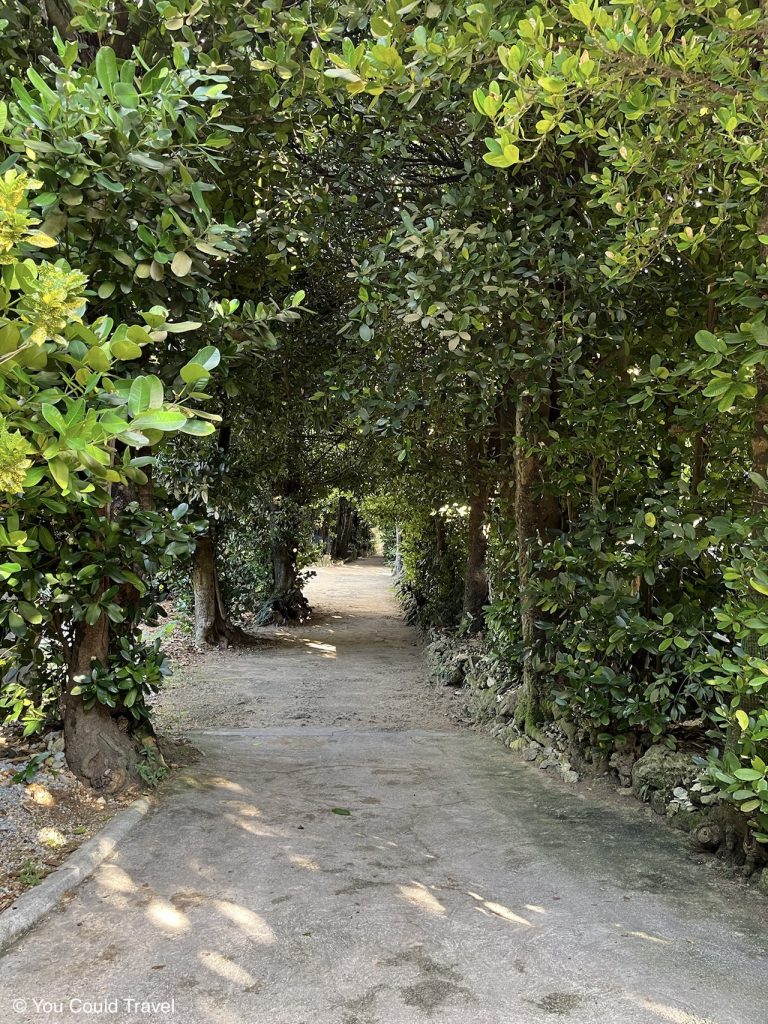


Leave a Reply